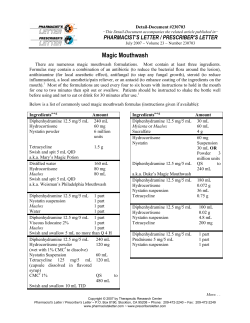
Lidocaine Plaster in Palliative Care Description
Palliative Care Guidelines: Lidocaine Plaster | Version 2 Lidocaine Plaster in Palliative Care Description •• Lidocaine is a local anaesthetic effective in some types of neuropathic pain such as post-herpetic neuralgia. •• It is available in a topical plaster formulation, with only 3% systemic absorption, reducing the risk of systemic adverse reactions and drug interactions. •• The use of lidocaine plasters in palliative care has not been investigated extensively and is outside marketing authorisation. It is non-Formulary in some NHS Boards. Preparation: Versatis® Medicated plaster (10x14cm) containing 700mg (5% w/w) of lidocaine. Indications A palliative care specialist may recommend lidocaine plasters for: •• localised neuropathic pain (particularly associated with allodynia) that is unresponsive to opioids and adjuvant analgesics. •• locally painful bone metastases unresponsive to standard treatments (paracetamol, opioids, adjuvant analgesics, radiotherapy) or when standard treatments are inappropriate, poorly tolerated or contraindicated. •• Short term treatment of localised, severe uncontrolled bone or neuropathic pain, while adjuvant analgesics are being titrated. Cautions • Do not apply the plaster to inflamed, broken or infected skin; or to wounds. • Use with caution in patients with severe cardiac disease; elimination may be delayed in patients with severe renal or liver impairment. Drug interactions • Use with caution in patients receiving a Class I anti-arrhythmic drug (eg flecainide). Side effects • Application site reactions including erythema, rash and pruritis are common. • Allergic reactions have been reported but are very rare. Dose & Administration Starting a lidocaine plaster • Remove any hairs with scissors; do not shave the area. • Plasters can be cut to size before the backing is removed without affecting drug delivery. • Apply one plaster directly over the painful area for up to 12 hours in each 24 hour period. The plaster free interval may reduce the risk of skin reactions. • The plaster site should be specified on the prescription chart and on the monitoring sheet. • A new plaster is applied every 24 hours. Titration • The dose is titrated to give adequate analgesia (up to a maximum of three plasters) depending on the number and size of the painful site or sites. • Monitor the patient’s pain and other analgesics; these may need to be reduced if the pain responds well to lidocaine. • A used plaster should be folded over and can then be put in the sharps bin or household waste. © NHS Lothian Re-issue date: August 2010 Review date: August 2013 1 Palliative Care Guidelines: Lidocaine Plaster | Version 2 Pain Assessment • A 0-10 pain scale should be used to assess the patient’s pain now and over the past 24 hours. • Record the pain scores on the monitoring sheet before the plaster is applied and after 48 hours. Review of lidocaine plaster •• Most patients will respond within 2 weeks; discontinue the plaster if no benefit. •• It is often possible to discontinue the plaster without the pain recurring as the local effect on nerve endings persists after the plaster is removed. •• If the pain resolves completely, try a plaster free period after 7 days of plaster use. •• remove the lidocaine plaster(s) for 24 hours and assess the patient. •• if the pain returns or worsens; restart the lidocaine plaster. •• if the patient remains pain free or with stable pain; discontinue the lidocaine plaster. •• Continued treatment - reassess with a further plaster free trial on a monthly basis. Monitoring • A monitoring sheet (page 3) is recommended for each patient started on a lidocaine plaster. • If a lidocaine plaster is being used for more than one pain site, a separate monitoring sheet should be completed for each site. • The monitoring sheet should be updated each time the patient is assessed. • Check the skin site – if a local reaction occurs, the plaster may need to be stopped. References 1. Galer BS. Topical lidocaine patch relieves postherpetic neuralgia more effectively than a vehicle topical patch: results of an enriched enrollment study. Pain 1999; 80: 533-8. 2. Rowbotham MC. Lidocaine patch: double-blind controlled study of a new treatment method for post-herpetic neuralgia. Pain 1996; 65: 39-44. 3. Gammaitoni AR. Pharmacokinetics and tolerability of lidocaine patch 5% with extended dosing. Ann Pharmacother 2002; 36: 236-40. 2 Re-issue date: August 2010 Review date: August 2013 © NHS Lothian Palliative Care Guidelines: Lidocaine Plaster | Version 2 © NHS Lothian Re-issue date: August 2010 Review date: August 2013 3
© Copyright 2025





















